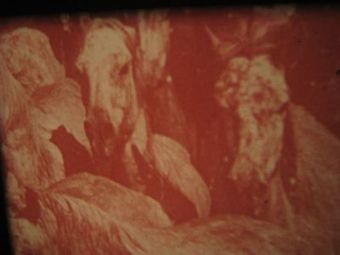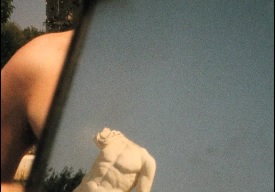
April 9, 8pm, Castro Theatre
First on the docket was the Stephen Parr tribute program. Having dipped my toe in the Oddball collection several years back, I had some personal interest in this. An outfit called the Red Room Orchestra was to play. Don't these films have soundtracks? Most do. How would this play out?
 |
However, his space on Capp St. would have been an apter site for this show than the Castro Theatre, not least because the throw and angle of projection, and general poor condition of the films, ensured that they would be badly out of focus much of the time. And it's hard to ignore a 13-piece orchestra on the stage and protruding into the image.
April 11, 6:30pm, Roxie Theater
The yearly experimental program is typically a fertile plot for exciting formal explorations. Every work in this iteration (purportedly) started or finished in 16mm, the majority did both.
The first two works shown, Pablo Mazzolo's NN and Jennifer Saparzadeh's Nu Dem, could not be shown on film, it was claimed, due to print damage sustained at prior venues. Co-curator Vanessa O'Neill sanguinely noted that both filmmakers had made DCP transfers so the screenings could still happen.
NN, in particular, showed off the pitfalls of this process. The motion in the work (shot from a moving train in a tunnel) has a very noticeable 1Hz stutter that I don't see mentioned in prior descriptions of Super-8 screenings (I presume that the 1976 newsreel footage Mazzolo reshot was 16mm). It is most likely due to the addition of a frame per second in the transfer to PAL video, carried over into the 25fps DCP. If the stutter is intentional, it's impossible to know so from watching the transfer. The dizzying POV footage itself is dynamite, but I wouldn't have guessed that it is "about" the atrocities of Argentina's military dictatorship 40 years ago. And that's OK.
Nu Dem reflects on the more recent political mess of refugees in Europe, with their "voices" on the soundtrack. I didn't notice any "mistakes" in the transfer, other than that mistake itself and the dead quality that results, nor do I remember much of the image at all.
arc's ascensions was an unfortunate choice to lead off the 16mm reel as it offers very little to focus on--brief flashes of light embedded in a morass of black leader. (In my own experience, this is an impossible task for a projectionist.) After a minute or so, when the picture sharpened, there was imagery there, but so fleeting i couldn't consciously decode it. I did see evidence of splices, though. Found footage perhaps? The effect was Brakhagian, as was arc's rambling, somewhat decipherable note in the program.
 |
The festival had intended to show Jim Jennings's 2001 film Day Dream, but as it exists only as a single known print, substituted another of his street films from several years later, Fashion Avenue. Appropriately sequenced after Shape, it is also built around mirrored imagery, but from the reflective surfaces of a bustling metropolis. And in contrast to Dinçel's pointed editing, Jennings cuts his shots together in a frenzy of patterns and flows, à la Dion Vigne.
Though Stephanie Barber's film is listed in the program as The Forest is Offended, the full title that jogs by on screen continues by Suggestions of Holiness and the Departures of Sound. Between attending to these words and trying to interpret the garbled soundtrack, I was unable to get any purchase on this brief film's images.
Alee Peoples's films have a wonderful playfulness about them, and in Decoy (which I missed in last year's Light Field), the play takes a dark turn. Clearly responding to current xenophobic tendencies in the U.S., she articulates variations on the theme of "wall": literal ones, shadowed ones, opposite ones (bridges), etc. The inclusion of incongruous messaging, ad imagery, and other strange pictorial amusements creates a pop-culture patina that implicates us all. When the sliding bars of a jail cell door cut to a waving flag, the effect is bold rather than heavy-handed. Another masterpiece from my favorite film artist of today.
The late Paul Clipson (who would surely have eventually garnered some Persistence of Vision type award from the festival) was to be represented by two recent films, At Hand and Spectral Ascension, but prints could not be prepared in time. Instead we were treated to two older pieces, Sphinx on the Seine and Chorus. Clipson's practice involved publicly screening his camera-original Super-8 footage in collaboration with live musicians as he whittled and worked his material down to its final form. We will never again share in this process, but we are left with his ultra-refined finished works. His signature camera technique was the repeated partial re-winding and re-exposing of his Super-8 cartridges, thus multiply superimposing shots, usually of the same subject. Sphinx takes this act on the road, cutting together a globe-trotting symphony of cities, while Chorus, literally shot on roads at night, propels the viewer into a delirious vortex of zoomed neon.
 |
8pm, Castro Theatre
I quickly zipped up to the Castro for the Blonde Redhead concert. Their set kicked off with some formless synth noodling, and for a moment I thought that this could be adapted to the rhythmic and emotional contours of the silent film they were ostensibly scoring. But... as soon as it started (Ozu's great rendering of youthful disillusionment and acceptance I Was Born, But...), the drummer laid into a driving beat rather unbefitting the stalled car on screen. After a spell I found I could tune out the band to some extent for a few minutes at a time, between eruptions of applause from the audience that had nothing to do with the film. The print was decent enough in contrast and image quality, excepting the occasional printed-in damage and the cropping. Though originally a full frame film, it seems at some time to have been duplicated through an Academy aperture, resulting in cropped heads, compromised compositions, and off-center intertitles.
April 14, 1pm, SFMoMA
I had never seen Lubitsch's To Be Or Not to Be, and I had to endure a longish interview with Novikoff award recipient Annette Insdorf first. In fact, she spoke well, discussing Holocaust films and the importance of a film's opening in teaching the viewer how to watch the remainder. To be indeed has a hilarious voiceover-driven opening, but I felt the rest of the movie could not sustain its momentum. To be fair, I have only so much attention to give and I might have been flagging too much after the interview to keep track of all the Doppelgänger. Also, the print suffered from its own doubling, as if it had been printed twice, in poor sync with itself. It's an effect I see sometimes but can't affix a cause to.
April 15, 5:45pm, PFA
I'm sure Nathaniel Dorsky would have had something to say, as a devotee of Ozu and of the purely visual cinematic experience, had he been at the Blonde Redhead debacle. Almost all his own films are silent and screened without accompaniment, including the four screened here: Autumn, The Dreamer, Avraham, and Intimations. I list them together as they do not entirely individuate in my memory. They do typically require that the viewer discard the expectation that a shot will necessarily be in focus, or "properly" exposed, or with its neighbors advance any narrative or otherwise expressible logic.
Often an out-of-focus shot serves to abstract the transformations that occur in it. Sometimes a shot reveals its scale and context by the reflections in a pane of glass through which he is shooting.
 |
The following Spring produced The Dreamer. As Dorsky says, this is a lighter and more florid film. I was struck by early shots of the moon and clouded skies that appeared sped up. His normal practice is to shoot at 24fps but to show at the more meditative speed of 18fps. These shots must have been undercranked. Intimations uncharacteristically contains several shots of conventionally-framed faces. One senses--and I may be off-base here--that Dorsky cares little for the people themselves (with the exception of Jerry Hiler, seen reading a newspaper), but rather for their distillations or occlusions of light.
I'm normally skeptical of films that rely on their makers' introductions for elucidation. But Dorsky is an avuncular and inspirational speaker, and one feels that the proper way to see his films must be at his place, among friends, and I appreciate the preliminary mood-setting he provides, even if I have to use my ears!
Posted April 22, 2018 at 11:15am:
An individual at this organization has hacked one of my email address and changed the password so that I am no longer able to access this email. Severl of my contacts have started receiving emails and I have advised them not to open these as they may be infected. I sent an email to the organization asking that they provide me with the password so that I can regain control of the email address but no one has responded.
I an concerned that others might be experiencing the same problem of haveing account hacked.
Posted April 24, 2018 at 1:39pm by Carl Martin:
I assure you noone here has the time or inclination to hack your email. Still, nice to see that comments are working!